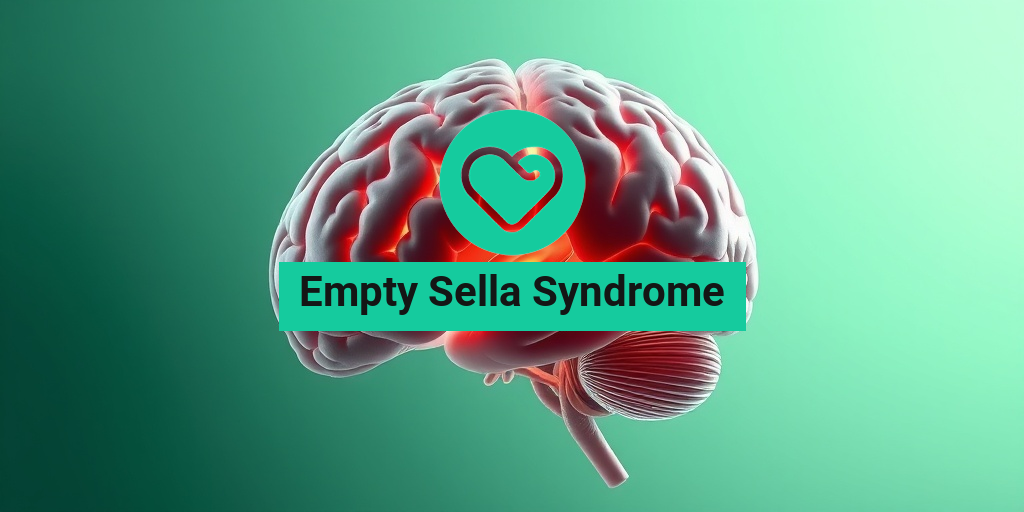What Is Empty Sella Syndrome?
Empty Sella Syndrome (ESS) is a condition characterized by the presence of an empty sella turcica, a bony structure at the base of the skull that houses the pituitary gland. In individuals with ESS, the pituitary gland may be flattened or partially absent, leading to various hormonal imbalances. This condition can be either primary or secondary. Primary ESS occurs without any underlying cause, while secondary ESS may result from previous surgeries, radiation therapy, or other medical conditions affecting the pituitary gland.
Although the term “empty sella” might sound alarming, many people with this condition experience no symptoms and may not even be aware they have it. In fact, ESS is often discovered incidentally during imaging studies, such as MRI scans, conducted for unrelated reasons. However, for some individuals, the absence or dysfunction of the pituitary gland can lead to significant health issues.
Causes of Empty Sella Syndrome
The exact cause of Empty Sella Syndrome is not fully understood, but several factors may contribute to its development:
- Congenital Factors: Some individuals may be born with a structural abnormality that predisposes them to ESS.
- Increased Intracranial Pressure: Conditions that lead to elevated pressure in the skull can cause the pituitary gland to be compressed or displaced.
- Previous Medical Treatments: Surgical interventions or radiation therapy targeting the pituitary gland can result in secondary ESS.
Understanding the underlying causes of ESS is crucial for effective management and treatment. If you suspect you may have this condition, consulting with a healthcare professional is essential.
Empty Sella Syndrome Symptoms
While many individuals with Empty Sella Syndrome remain asymptomatic, some may experience a range of symptoms due to hormonal imbalances. The symptoms can vary widely depending on the extent of pituitary dysfunction and the specific hormones affected.
Common Symptoms
Here are some of the most frequently reported symptoms associated with ESS:
- Fatigue: Chronic tiredness can occur due to hormonal deficiencies, particularly if the adrenal or thyroid hormones are affected.
- Weight Changes: Unexplained weight gain or loss may be linked to hormonal imbalances.
- Menstrual Irregularities: Women may experience changes in their menstrual cycle, including amenorrhea (absence of menstruation).
- Headaches: Some individuals report recurrent headaches, which may be related to increased intracranial pressure.
- Visual Disturbances: In rare cases, pressure on the optic nerves can lead to vision problems.
Diagnosis of Empty Sella Syndrome
Diagnosing Empty Sella Syndrome typically involves imaging studies, particularly MRI scans, which can reveal the empty sella turcica and assess the size and function of the pituitary gland. Blood tests may also be conducted to evaluate hormone levels and identify any deficiencies.
Treatment Options
The treatment for ESS largely depends on the symptoms and hormonal deficiencies present. In many cases, no treatment is necessary if the individual is asymptomatic. However, if hormonal imbalances are identified, hormone replacement therapy may be recommended to restore normal levels and alleviate symptoms.
For those experiencing significant symptoms or complications, a multidisciplinary approach involving endocrinologists, neurologists, and other specialists may be beneficial. It’s essential to work closely with healthcare providers to develop a personalized treatment plan.
If you’re looking for more information on Empty Sella Syndrome and its management, consider visiting Yesil Health AI for evidence-based health answers and resources.
In conclusion, while Empty Sella Syndrome can sound daunting, many individuals live healthy lives without significant issues. Awareness of the symptoms and potential treatments can empower those affected to seek appropriate care and maintain their well-being. 🌟

Causes of Empty Sella Syndrome
Empty Sella Syndrome (ESS) is a condition characterized by the presence of an empty sella turcica, a bony structure at the base of the skull that houses the pituitary gland. Understanding the causes of this syndrome is crucial for diagnosis and management. Here are some of the primary causes:
1. Congenital Factors
Some individuals are born with a structural abnormality that predisposes them to Empty Sella Syndrome. This can include:
- Developmental anomalies: In some cases, the sella turcica may be larger than normal or improperly formed, leading to an increased likelihood of the pituitary gland being compressed or displaced.
- Genetic predisposition: Certain genetic conditions may increase the risk of developing ESS, although specific genes have yet to be definitively linked to the syndrome.
2. Acquired Factors
Acquired causes of ESS often stem from medical conditions or external factors that affect the pituitary gland. These include:
- Increased intracranial pressure: Conditions that lead to elevated pressure within the skull, such as idiopathic intracranial hypertension, can push the pituitary gland against the sella turcica, causing it to flatten or become displaced.
- Trauma: Head injuries or trauma can damage the pituitary gland or the surrounding structures, leading to the development of ESS.
- Radiation therapy: Patients who have undergone radiation treatment for brain tumors or other conditions may experience damage to the pituitary gland, resulting in an empty sella.
- Pituitary gland disorders: Conditions such as pituitary adenomas (benign tumors) can lead to the destruction or displacement of the gland, contributing to ESS.
3. Hormonal Changes
Hormonal fluctuations, particularly during pregnancy or menopause, can also play a role in the development of Empty Sella Syndrome. These changes may affect the size and function of the pituitary gland, leading to its displacement.
Risk Factors for Empty Sella Syndrome
While anyone can develop Empty Sella Syndrome, certain risk factors may increase the likelihood of its occurrence. Understanding these factors can help in early detection and management.
1. Gender
Research indicates that women are more likely to develop Empty Sella Syndrome than men. This disparity may be linked to hormonal differences and the effects of pregnancy on the pituitary gland.
2. Age
ESS is more commonly diagnosed in adults, particularly those between the ages of 30 and 50. As individuals age, the risk of developing conditions that can lead to ESS, such as hormonal changes and increased intracranial pressure, may rise.
3. Obesity
Obesity is a significant risk factor for many health conditions, including Empty Sella Syndrome. Increased body weight can contribute to elevated intracranial pressure, which may, in turn, affect the pituitary gland.
4. History of Head Trauma
Individuals with a history of head injuries or trauma are at a higher risk for developing ESS. Such injuries can lead to structural changes in the brain and surrounding areas, impacting the pituitary gland’s position and function.
5. Previous Medical Treatments
Patients who have undergone treatments such as radiation therapy for brain tumors or surgeries involving the pituitary gland may be at an increased risk for developing Empty Sella Syndrome. These interventions can lead to damage or displacement of the gland.
6. Family History
A family history of pituitary disorders or Empty Sella Syndrome may also increase an individual’s risk. Genetic factors can play a role in the structural integrity of the sella turcica and the pituitary gland.
In summary, understanding the causes and risk factors associated with Empty Sella Syndrome is essential for early diagnosis and effective management. If you suspect you may be experiencing symptoms related to this condition, it is important to consult with a healthcare professional for further evaluation and guidance. 🩺

Diagnosis of Empty Sella Syndrome
Diagnosing Empty Sella Syndrome (ESS) can be a complex process, as the condition often presents with subtle symptoms that may overlap with other health issues. Typically, the diagnosis involves a combination of clinical evaluation, imaging studies, and laboratory tests.
Clinical Evaluation
The first step in diagnosing ESS usually involves a thorough clinical evaluation by a healthcare provider. During this evaluation, the doctor will:
- Review the patient’s medical history, including any symptoms such as headaches, vision changes, or hormonal imbalances.
- Conduct a physical examination to assess neurological function and any signs of pituitary dysfunction.
Common symptoms that may prompt further investigation include:
- Chronic headaches
- Visual disturbances
- Fatigue or weakness
- Changes in menstrual cycles in women
Imaging Studies
Once the clinical evaluation is complete, imaging studies are typically the next step. The most common imaging technique used to diagnose Empty Sella Syndrome is magnetic resonance imaging (MRI). An MRI can provide detailed images of the pituitary gland and surrounding structures, helping to identify:
- The presence of an empty sella, which appears as a flattened or absent pituitary gland.
- Any potential abnormalities in the surrounding brain structures.
In some cases, a CT scan may also be used, but MRI is generally preferred due to its superior soft tissue contrast.
Laboratory Tests
In addition to imaging, laboratory tests may be conducted to assess hormone levels. This is crucial because Empty Sella Syndrome can lead to hormonal deficiencies. Blood tests may include:
- Thyroid function tests
- Adrenal function tests
- Sex hormone levels
These tests help determine if the pituitary gland is functioning properly and if any hormonal imbalances are present.
Complications of Empty Sella Syndrome
While many individuals with Empty Sella Syndrome may remain asymptomatic, there are potential complications that can arise, particularly if the condition leads to hormonal deficiencies or other related issues.
Hormonal Deficiencies
One of the most significant complications of ESS is the risk of hormonal deficiencies. The pituitary gland plays a crucial role in regulating various hormones in the body, and when it is compromised, it can lead to:
- Adrenal insufficiency: This can result in fatigue, weakness, and low blood pressure.
- Hypothyroidism: Symptoms may include weight gain, depression, and sensitivity to cold.
- Hypogonadism: In men, this can lead to reduced libido and erectile dysfunction, while women may experience irregular menstrual cycles.
Vision Problems
Another potential complication is the development of vision problems. The pituitary gland is located near the optic nerves, and any enlargement or pressure from surrounding structures can lead to:
- Visual field defects
- Blurred or double vision
Regular monitoring and follow-up with an eye specialist may be necessary for individuals experiencing these symptoms.
Psychological Impact
The psychological impact of living with Empty Sella Syndrome should not be overlooked. Chronic symptoms such as headaches and hormonal imbalances can lead to:
- Anxiety: Concerns about health and well-being can contribute to anxiety disorders.
- Depression: The chronic nature of symptoms may lead to feelings of hopelessness or sadness.
It is essential for patients to have access to mental health support and counseling as part of their overall treatment plan.
In summary, while Empty Sella Syndrome can often be managed effectively, awareness of potential complications is crucial for maintaining overall health and well-being. Regular follow-ups with healthcare providers can help mitigate these risks and ensure appropriate management of any arising issues. 🩺

Treatment Options for Empty Sella Syndrome
Empty Sella Syndrome (ESS) is a condition characterized by the presence of an empty sella turcica, a bony structure at the base of the skull that houses the pituitary gland. While many individuals with ESS may not experience significant symptoms, others may require treatment to manage associated issues. Understanding the treatment options available can help those affected lead a more comfortable life.
Understanding the Need for Treatment
Not everyone diagnosed with Empty Sella Syndrome will need treatment. In fact, many people are asymptomatic and may only discover their condition incidentally during imaging studies for unrelated issues. However, for those who do experience symptoms, such as hormonal imbalances or headaches, treatment becomes essential.
Hormonal Replacement Therapy
One of the most common treatment options for individuals with Empty Sella Syndrome is hormonal replacement therapy. Since the pituitary gland plays a crucial role in hormone regulation, any dysfunction can lead to hormonal deficiencies. Depending on the specific hormones affected, treatments may include:
- Thyroid Hormones: If the thyroid-stimulating hormone (TSH) is low, thyroid hormone replacement may be necessary.
- Corticosteroids: For those with adrenal insufficiency, corticosteroids can help manage symptoms.
- Sex Hormones: Estrogen or testosterone replacement may be recommended for individuals experiencing reproductive issues.
Medications for Symptom Relief
In addition to hormonal therapies, medications may be prescribed to alleviate specific symptoms associated with Empty Sella Syndrome. For instance:
- Pain Relievers: Over-the-counter pain medications can help manage headaches.
- Antidepressants: If mood disorders arise, antidepressants may be beneficial.
Surgical Options
In rare cases, surgical intervention may be necessary, especially if there are complications such as a pituitary tumor or significant cerebrospinal fluid leakage. Surgical options can include:
- Transsphenoidal Surgery: This minimally invasive procedure allows surgeons to access the pituitary gland through the nasal cavity.
- Repair of CSF Leaks: If cerebrospinal fluid leaks are present, surgical repair may be required.
Regular Monitoring and Follow-Up
For many individuals with Empty Sella Syndrome, regular monitoring is crucial. This may involve:
- Endocrinologist Visits: Regular check-ups with an endocrinologist can help manage hormonal levels.
- Imaging Studies: Periodic MRI scans may be recommended to monitor any changes in the sella turcica.
Living with Empty Sella Syndrome
Living with Empty Sella Syndrome can present unique challenges, but with the right support and management strategies, individuals can lead fulfilling lives. Here are some tips for navigating daily life with this condition.
Understanding Your Condition
Knowledge is power. Understanding Empty Sella Syndrome and its potential effects on your body can help you make informed decisions about your health. Educate yourself about:
- The role of the pituitary gland in hormone regulation.
- Common symptoms and how they may manifest in your life.
- Available treatment options and their potential side effects.
Building a Support Network
Connecting with others who have Empty Sella Syndrome can provide emotional support and practical advice. Consider:
- Support Groups: Look for local or online support groups where you can share experiences and coping strategies.
- Healthcare Team: Maintain open communication with your healthcare providers, including endocrinologists and primary care physicians.
Adopting a Healthy Lifestyle
Maintaining a healthy lifestyle can significantly impact your overall well-being. Focus on:
- Balanced Diet: Incorporate a variety of fruits, vegetables, whole grains, and lean proteins into your meals.
- Regular Exercise: Engage in physical activity that you enjoy, whether it’s walking, yoga, or swimming.
- Stress Management: Practice relaxation techniques such as meditation, deep breathing, or mindfulness to reduce stress levels.
Monitoring Symptoms
Keep a journal to track your symptoms, medication, and any changes in your health. This can help you and your healthcare team make informed decisions about your treatment plan. Note any:
- Changes in mood or energy levels.
- Physical symptoms such as headaches or fatigue.
- Responses to medications or therapies.
By taking proactive steps and staying informed, individuals living with Empty Sella Syndrome can manage their condition effectively and enhance their quality of life. 🌟

Frequently Asked Questions about Empty Sella Syndrome
What is Empty Sella Syndrome?
Empty Sella Syndrome (ESS) is a condition where the sella turcica, a bony structure at the base of the skull that houses the pituitary gland, appears to be empty on imaging studies. This can occur due to various reasons, including the flattening of the pituitary gland or the presence of cerebrospinal fluid in the sella.
What are the symptoms of Empty Sella Syndrome?
Many individuals with Empty Sella Syndrome may not experience any symptoms. However, some common symptoms can include:
- Headaches 🤕
- Visual disturbances 👁️
- Hormonal imbalances
- Fatigue
What causes Empty Sella Syndrome?
The causes of Empty Sella Syndrome can vary, but they often include:
- Congenital factors (present at birth)
- Previous pituitary surgery or radiation therapy
- Increased intracranial pressure
How is Empty Sella Syndrome diagnosed?
Diagnosis typically involves imaging studies, such as an MRI, which can reveal the characteristic appearance of the sella turcica. A healthcare provider may also conduct blood tests to check for hormonal levels.
What is the treatment for Empty Sella Syndrome?
Treatment for Empty Sella Syndrome depends on the symptoms and underlying causes. Options may include:
- Hormone replacement therapy for hormonal deficiencies
- Medications to manage symptoms
- Regular monitoring and follow-up with a healthcare provider
Is Empty Sella Syndrome a disability?
Whether Empty Sella Syndrome qualifies as a disability can depend on the severity of symptoms and their impact on daily life. It is advisable to consult with a healthcare professional for a thorough evaluation.
What is the ICD-10 code for Empty Sella Syndrome?
The ICD-10 code for Empty Sella Syndrome is E23.0. This code is used for medical billing and documentation purposes.
Can Empty Sella Syndrome affect vision?
Yes, some individuals with Empty Sella Syndrome may experience visual disturbances due to pressure on the optic nerves. If you notice any changes in your vision, it is important to seek medical attention.
Is there a link between Empty Sella Syndrome and other conditions?
There may be associations between Empty Sella Syndrome and other conditions, such as hormonal disorders or increased intracranial pressure. A comprehensive evaluation by a healthcare provider can help determine any potential links.
Where can I find more information about Empty Sella Syndrome?
For more information, consider consulting reputable medical websites, speaking with a healthcare provider, or visiting organizations that specialize in pituitary disorders.




